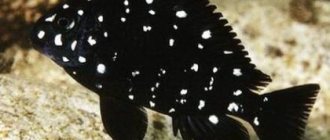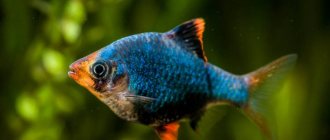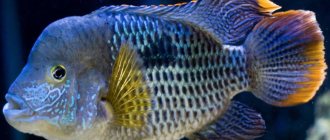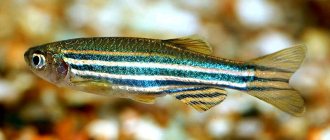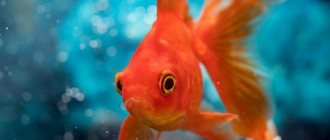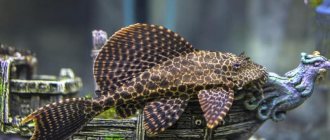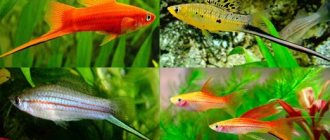5
(5)
The catfish family is extremely popular in the aquarium hobby. In any pet store you can find dozens of representatives, but there are also quite rare specimens that are not always available for sale. These include the catfish agamix. Not surprising, since in captivity it reproduces extremely reluctantly and individuals are most often simply caught in the wild. Nevertheless, this is a rather interesting animal that has certain habits and characteristics.
Description of appearance
In nature, the agamix star catfish grows up to 17 cm, in an aquarium - no more than 12 cm. The head is large, triangular, with six spotted whiskers, located on a strong body covered with plates for protection. The body ends with a narrow tail. On the back there is a triangular fin with notches on the first ray. The fins on the abdomen are round and small. They are very tough and covered with spines, which straighten out in case of danger.
The body of the catfish is massive, covered with durable bony plates.
On the brown (or black) sides of the fish, small yellow spots (white in juveniles) are clearly visible, which turn into stripes on the tail.
From Omics, speckled fish are called singing or grumbling because they can make sounds: crackling their pectoral fins or resonating with their swim bladder. This is how agamixes attract partners or scare enemies.
Behavior and Compatibility
Agamix star is a peaceful catfish that feels good in a community aquarium. It gets along well with most other medium and large fish; it can only snack on very small fish. Gets along well with barbs, gouramis, angelfish, thorns, and small cichlids of South and Central America. It can be kept alone, but it is better in a small flock.
Behavior in the wild
The South American representative of freshwater fauna, Agamix speckled, lives in the upper reaches of the Amazon, in the Venezuelan Orinoco River, as well as in Brazilian and Peruvian lakes. It prefers to settle in clean bottom layers of shallow water with calm, warm water and a densely overgrown shore.
It is active at night. During the daytime it hides between stones and under snags. It feeds on mollusks and snails.
Agamix belongs to the bottom representatives of aquatic fauna, therefore it prefers clean water with an average flow speed
Surprisingly, these fish have the ability to move on their powerful fins on land to bodies of water located close to each other.
If there is not enough oxygen in the water, they rise to its surface. These catfish have both gill and intestinal respiration. This is how they make up for the lack of oxygen.
Agamix spawns during the rainy season; the female is capable of laying from 2 to 3 thousand eggs per spawning.
Feeding catfish fry "Ancistrus stellata"
The fry begin to be fed on the 4th day after the larvae emerge from the eggs. In the first days they are fed with the smallest plant foods. The nursery aquarium must contain driftwood and coconut shells, preferably old and well-soaked. From the first days the fry actively gnaw them. As the fry grow, they need to be switched to larger food. Over time, live food and algae tablets must be introduced into the fry’s diet.
It is best to take a large aquarium for raising fry. In volumes of 200-300 liters, the conditions for growing catfish are much more stable than in small aquariums, and this is the main requirement in the first 2 months of the life of ancistrus fry. It is important to keep the nursery aquarium clean. The water for fry should be as clean as possible, so it is necessary to remove any leftover food and change the water daily.
It is better not to transport the fry during the first months of life. This can have a negative impact on their health and can easily lead to death. It is best to transport fry when they reach the age of 5-6 months. At this age, they already reach a size of 5-7 cm and can tolerate transportation quite easily. In a new place, the grown fry adapt and take root much better.
Star ancistrus are quite secretive fish. They tend to hide in the daytime in shelters or in thickets of plants. Being nocturnal, they become active only in the dark. This especially happens in a new place, when they are not yet accustomed to new conditions. Over time, the fish become less shy. After being in the new aquarium for some time, they get used to it, come out of hiding and take food even during the day.
Maintenance and care in the aquarium
In one aquarium you can keep 4-6 star catfish. But you can place one agamix with other friendly species of fish of similar size.
Catfish can be kept in a flock of 4-6 individuals
To catch catfish when transplanting them into another container, you should not use a net. The fish's sharp fins easily become entangled in the net and can injure the owner's hands when untangled. A plastic mug works best.
Since in nature the diet of the agamix catfish consists of mollusks, it can eat aquarium snails.
The naturally timid catfish hides all day in shelters at the bottom of the aquarium, and at night swims out, actively exploring the bottom in search of food.
Rule 1. Spacious aquarium
The volume of the agamix aquarium will directly depend on the number of individuals. A group of 5 fish requires a 100 liter tank. Catfish love space and free movement.
The optimal volume of an aquarium for catfish is at least 100 liters
An aquarium with a top cover cannot be filled with water to the brim. Agamix must be able to rise to perform intestinal respiration.
Speckled catfish require filtration and aeration of the aquarium. You need to install a dim light in it.
Rule 2. Suitable water
Water parameters for keeping agamix should strive for the following indicators:
- water temperature - within 25 degrees;
- acidity - 6-8 pH;
- hardness - up to 25 dH.
You can provide a current, but not a strong one. Change the water partially every week within 25-30% of the aquarium volume. You can change 2 times a week by 10-15%.
It is recommended to change the water in the aquarium several times a week
It is better to pass tap water for use in an aquarium through a filter.
Rule 3. Suitable equipment
You need to buy a special bottom filter at the pet store, since catfish mainly lead a bottom-dwelling lifestyle. An external type filter won't hurt either.
Rule 4. Soil without sharp stones
It is recommended to use a thick layer of coarse river sand or small round pebbles as a substrate in an agamix aquarium so that the catfish do not get injured.
Sand or rounded pebbles can be used as soil.
Rule 5. Decorations close to natural
It is best to create conditions in an aquarium for keeping agamix starfish that are as close to natural as possible. To do this, equip as many shelters for the catfish as possible: install grottoes, secure driftwood at the bottom, lay out stones.
Decorate with broad-leaved aquatic plants with strong roots (echinodorus, cryptocorynes, ferns), algae, or use artificial vegetation. Agamix will not cause any harm to either one or the other.
Echinodorus aquarium
Cryptocoryne
Fern
Rule 6. Protein feed as the basis of nutrition
The diet of the agamix predator must be composed of protein-rich food. It prefers bloodworms, brine shrimp, tubifex or earthworms in its menu. He eats well the dry food specially balanced for catfish.
It is important that the feed falls to the ground. The agamix easily finds it there.
Agamix is prone to overeating. Therefore, food should be given to him once a day in the evening in such quantities that he will eat in 2 minutes. Uneaten food heavily pollutes the soil, which adversely affects the health of the catfish.
Speckled agamix will not refuse plant foods such as algae, but in small quantities, approximately 1/4 of the total feeding volume.
Bloodworm
Artemia fish food
Tubifex for aquarium fish
Earthworms
Food and feeding
Agamix is omnivorous and not picky about feeding, but the main diet should be protein. In the wild, it feeds on a variety of crustaceans, worms, insects and plants. Catfish are bottom dwellers and will eat any food that falls to the bottom in an aquarium. Feed them daily before or after turning off the lights in the aquarium.
Suitable food options include special sinking tablets for catfish, frozen bloodworms, brine shrimp, shrimp, and mussels. They will eat snails, so they can be used to clear out snails from your aquarium.
Diseases and their prevention
The agamix catfish may not get sick at all if the conditions necessary for its maintenance in captivity are organized and fed correctly.
Detecting the disease in agamix is quite difficult due to their nocturnal lifestyle.
The most common disease to which agamixes are susceptible is ichthyophthoriosis, which occurs from damage by ciliated ciliates. With this disease, white dots appear along the entire length of the fish’s body (as if semolina had been scattered). The catfish begin to actively rub against the soil and vegetation in the aquarium.
Agamix are susceptible to ichthyophthoriosis
For treatment, place the fish in a separate aquarium and use antiparasitic drugs prescribed by a specialist. It is necessary to change 10% of the water in the aquarium daily while simultaneously increasing the water temperature by 5-10 degrees.
Individuals just purchased from a store must be kept in quarantine.
Oodiniosis, velvet disease, may not appear immediately. Pisces become less active. The skin peels off and resembles velvet. The disease is treated by adding the antibiotic Bicillin-5 to the aquarium water (1 bottle per 100 l). The next day, change the water by 30% and re-add the drug. After 2 days everything is repeated. The last time Bicillin is added is a week later. This kills the algae in the aquarium, but the fish recovers. Do not stop aeration during treatment.
Oodiniosis in catfish is treated with the antibiotic Bicillin-5
Chylodonellosis is the appearance of cloudy blue areas on the body of catfish, the tail of the fish is tightly compressed. Treat with Levomycetin (3 g per 100 l). It is added 3 times every 48 hours. Before this, change the water by 1/3. You also need to increase its temperature to +28-30 °C and add 3 tbsp. l. table salt.
Levomycetin is used to treat chylodonellosis.
Plants may die during the treatment period.
Another disease of Agamix catfish is dropsy. Symptoms include a swollen abdomen and lack of bowel movements. The sick fish is sent for quarantine to another aquarium, where Levomycetin (75 ml/l) or Ciprofloxacin (50 ml/l) is added to water at a temperature of 27 degrees. Treatment lasts 7 days. In a recovered fish, the belly decreases in size and the fish begins to defecate.
To treat dropsy in catfish, add Levomycetin or Ciprofloxacin to the water.
How to keep agamixis?
As with other aquatic life, the happy and long life of the agamix catfish depends on creating conditions that are as close to natural as possible.
Aquarium. To keep this peace-loving fish, you need a fairly large aquarium, with a capacity of at least 100 liters, with clean water and a temperature of +25 degrees.
Water parameters. No special maintenance regime is required, nor is there any need for bright lighting. On the contrary, the light should be dim, as in the bottom layer of a natural reservoir. The optimal water hardness should be around 8°, and the acid-base balance (pH) should be close to neutral (from 6 to 8 units). It is advisable to change the water more often, 2-3 times a week, approximately 10% of its total volume.
The soil in the aquarium should be sandy or fine gravel. It is better to sprinkle the bottom substrate in a thick layer, since catfish really like to dig it. Experts strongly recommend building grottoes and caves in the aquarium, installing driftwood, thus creating an environment in which there would be several places for shelter and daytime rest. Agamix welcomes the presence of aquatic plants, since in natural conditions it lives among tropical thickets.
Filtration. To purify water, it is better to use a powerful filter with high-quality mechanical and biological filtration. The fact is that during the life of agamixis, a fairly large amount of waste is generated.
If it is necessary to transfer the fish to another container, then experienced aquarists do not recommend using a regular net, as the bony fins may become entangled in it. It is better to use a net made of thick fabric.
Compatibility with other fish
The predatory catfish agamix, with its surprisingly calm character, is very friendly with guppies, gouramis, swordtails, neons, barbs, angelfish, that is, with those species of fish that live in the water column (and not at the bottom) and do not bother the secretive catfish. Small individuals can become its prey at night.
You cannot add agamix to cichlids, otherwise the singing catfish themselves may be eaten by these aggressive predators.
Compatibility table of agamix with other fish
Content
Star catfish are unpretentious and survive in wide ranges of temperature and water hardness. You can recommend the fish to responsible beginners who will monitor the cleanliness of the soil and water.
Aquarium
A 50-liter aquarium is enough for one star ancistrus. For two individuals, 200 liters is better to prevent clashes. It is optimal to keep a male and 2 females. Place driftwood, which will serve as a source of beneficial supplements. Wood plays an important role in the digestion of fish. Ancistrus gnaws nutrients from the surface of driftwood. Neglecting this advice will lead to fish illnesses. Other shelters are also needed, among which the star catfish will hide:
- grottoes;
- caves;
- piles of stones.
View this post on Instagram
L404 tank again with plenty of l404 and L181 juvies leaving caves all the time. #l404 #l181 #hypancistrus #ancistrus #starlightpleco #pleco #countrysideaquatics #plecobreederandseller #pleco #staffspleco #plecobreeding #rareaquatics #staffsfishsales #stokepleco #staffspleco #midlandsplecocenter
A post shared by Carl Dutton (@countryside_aquatics) on Oct 1, 2018 at 8:54am PDT
Water parameters
| temperature | 20–28 degrees |
| rigidity | 1–20 dGh |
| acidity | 6–7.5 pH |
Change a quarter of the water volume to fresh water weekly and clean the soil with a siphon.
Plants
You don't need a lot of plants, but a few plant covers are advisable. The relationship of star catfish to plants varies. Ancistrus sometimes damage tender plants, especially Echinodorus and Schisandra, even if the diet includes a sufficient amount of herbal supplements. In some cases, fish are kept in herbal gardens, where the plants remain unharmed. Secure the roots by pressing them with a stone or attaching the plant to a piece of driftwood, then the catfish will not dig them up. Suitable for keeping with Ancistrus:
- Anubias;
- Vallisneria;
- Java moss;
- Cladophora;
- duckweed.
Priming
Place pebbles or gravel on the bottom. You can mix pebbles with sand. Make sure the stones do not have sharp corners. Boil the soil before placing it in the aquarium.
Equipment
For a full life of fish you will need:
- filter;
- compressor;
- heater.
Provide ancistrus with high-quality aeration and filtration. Heating the aquarium is necessary when the room temperature is low.
Lighting
If there are light-loving plants in the aquarium, make sure that they have enough light. Ancistrus is comfortable in dim, diffused light.
Breeding
Reproduction of grunt catfish at home is a complex process. Rarely do any professional aquarists take up the task of breeding them.
These fish reach sexual maturity at 1.5-2 years. Adult females appear larger and rounder than males, but are less vibrant in color. Fry cannot be distinguished by these characteristics.
Agamix females are usually more rounded, with a large abdomen
To stimulate the reproduction process, a special gonadotropic drug must be injected into the back muscles of the fish. Then the male and female are placed in an aquarium with a water level of 30 cm with one or two plants located there, for example, Congolese fern in pots (or Bolbitis Gedeloti). No soil is placed on the bottom.
The water temperature in such an aquarium should be maintained within 27 degrees, aeration should be enhanced.
The amount of feed during this period should be increased.
On the wide leaves of plants, the female carries out the process of laying eggs (up to 1000 pieces). After this, the couple is removed from the aquarium (so as not to eat the eggs) and 90% of the total water volume is replaced.
Experts recommend adding methyl blue (light coloring) and salt to the water with future fry at the rate of 2 grams per 1 liter of water. This will protect them from diseases.
To protect fry from diseases, it is recommended to add methyl blue to the water.
After 2-3 days, you can observe the emergence of fry from the eggs . They need to be fed food that is ground into powder: small plankton or live dust.
Reduce the water temperature to 24-25 degrees, increase filtration and aeration. Change 1/10 of the total volume of water in the aquarium daily. Maintain its level at a height of 10 cm.
The fry begin to actively move in the aquarium 5-6 days after their birth.
Conditions and characteristics of reproduction
The fish reach sexual maturity at the age of 2 years, but there is practically no information about the conditions for independent reproduction of Agamix stellata in captivity.
This is due to the fact that a narrow circle of professional aquarists are engaged in breeding such fish, stimulating spawning artificially by injecting human chorionic gonadotropin, a hormonal drug, into the animal’s back muscles.
The experimentally tested dose of the drug is 0.2 ml per injection.
The pair is placed in a separate spawning tank without soil, in the center of which a bush of Congolese fern, or Bolbitis Gedeloti, is installed in a pot. The female lays eggs on the leaves of the plant, the number of which usually does not exceed 100 pieces.
The incubation period is short, maximum 2 days. When the fry begin to swim independently, they can be given small food: brine shrimp and tubifex.
The tropical catfish agamix star-shaped, or white-spotted agamixis, has not yet become widespread enough among amateur aquarists
And completely undeservedly, since its content does not cause any special problems, and its original coloring and ability to make sounds always attract the attention of others. It is quite possible that there would be much more admirers of this exotic fish if its specimens appeared more often in pet stores
Possible difficulties
When keeping white-spotted agamix, some difficulties may arise, the following recommendations will help you cope with them:
- To ensure that your fish does not suffer from obesity, it is necessary to strictly follow the correct diet.
- Oxygen starvation of catfish occurs most often if the water temperature in the aquarium is higher than the required norm. You should cool the water by adding a little cold water and increase aeration. Too many fish in one aquarium can also cause a lack of oxygen.
- Poisoning in agamix can occur due to excess nitrites and ammonia in aquarium water. It is necessary to regularly test the water using drop tests. They can be purchased at a pet store. You can eliminate poisoning by replacing up to 40% of the water in the aquarium. To do this, add special conditioners that neutralize substances harmful to fish.
- Unnatural white spots on the fish's body may appear due to stress. In a stressful situation, agamixes become dull and partially lose pigmentation. This can happen when transplanting a catfish from a familiar container to another aquarium, as well as after transportation. As you get used to it, the spots will disappear.
Due to the lack of movement, the choice of menu for catfish should be approached responsibly
A real, albeit small, singing catfish, star agamix, with unusual habits and peaceful behavior will delight the aquarist owner.
Did you find the agamix catfish interesting to keep in your home aquarium? Or maybe you already have it? Share your opinions and experiences in the comments.
Differences between females and males
As with all loricaids, the adult male stellate ancistrus is easily distinguishable from the female. These differences appear starting from the seventh month: the male begins to grow long tentacles (leathery processes) on his face, which
grow all over the head (look at the photo of the male stellate ancistrus).
Females can also have such outgrowths, but they are shorter and their area of distribution is only along the edge of the upper jaw. The male's body is much longer than the female's.
Reviews
The star-shaped inhabitants of the aquarium delight aquarists. Breeders value fish for their slowness and unique appearance. Star Ancistrus has helped many in the fight against algae.
